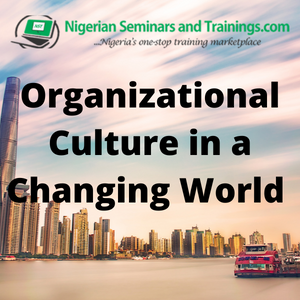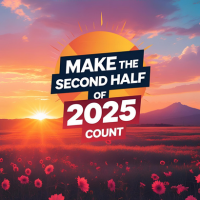 |
Organizational Culture in a Changing World |
The idea of change can be deeply disturbing, unsettling, and worrisome. Yes, it is! Often, organizations prefer the comfortable and familiar paths which have helped define their past, amid huge successes or less. The illusion that an organization can stand still while the rest of the world is in constant motion is just that-an illusion. The imperative for change becomes much more critical since every organization exists within the parameters of time, geography, culture, among others.
Every organization is exposed to the dynamics of external and internal forces, which are also subject to change. The external forces being political, economic, socio-cultural, legal, environmental, and technological realities, as well as internal forces - wherein lies organizational culture.
While change is inevitable, our response as an organization isn’t. We can adopt either two attitudes-fix our eyes on the past or turn around and face the future, with all its uncertainties, opportunities, and challenges.
Since we may acknowledge the certainty of change, critical questions that must be asked and answered are: “How can we guide and channel these forces of change - with its energy and creativity, to aid the organizational mission in the context of organizational culture? Do we allow change to drive its life within the organization and probably drive the organizational mission and organizational culture?
But before we answer these questions, we need to know the meaning of organizational culture.
Simply put, organizational culture describes the life of the community within an organization, which can be formal or informal, a combination of its belief/belief system, values/value drivers, hierarchy/organizational structure, way of life, policies (written or unwritten) - a form of constitution, which is/can be handed down to generations. Organizational culture gives the organization its unique identity in the marketplace which lends credence to its mission.
Every organization has pressure points for change which comes from diverse sources-points that will test its culture. This culture consists of two parts - the “non-negotiables”, which are not/may not be ‘up for grabs’ and the “negotiable”.
The questions we must always ask ourselves from time to time are these:
- Do the “non-negotiables” and “negotiable” aid the organizational mission?
- Are they still relevant? Now, in the next 5, 10 years, etc?
- When does a “non-negotiable” become “negotiable” and vice versa?
- When do we bring new “negotiable(s)”/ “non-negotiable(s)” into the organization cultural mix?
- How and what are the criteria to be used?
- Who within the organization should set the criteria?
Organizations that are champions of status quo go into oblivion or at best lose their place (Is it really their place?) to those who constantly transform themselves in a world of change. Organizations that identify with and hold tenaciously to their “non-negotiables” approach change from a position of strength and certainty. But the question that arises also is this, for how long?
On the other hand, organizations that see everything as “negotiables” have the advantages of inclusiveness and high attractiveness. However, with this scenario, the organization runs the risk of losing its identity in the marketplace which may jeopardize its mission.
This shows that every sustainable organization needs to explore the delicate balance between the “non-negotiables” and the “negotiables” in its quest to fulfill and achieve its organizational mission. At least, this is common sense!
When to Embrace Change
Most organizations will not embrace change or will only do so when forced by the forces of change at a very huge cost. Rather than pioneer change, many organizations allow change to pounce on them unexpectedly. The end results may not always be palatable.
Organizations need not wait for pressure points before embracing change. Sadly, this is the case for most organizations.
Factors that could indicate the necessity to embrace change in your organizational culture include, but not limited to:
- Increasing loss of market share
- Huge /Increasing annual staff turnover
- Reduced profitability
- Communication gap-lateral and vertical
- Increasing volume of customer complaints/dissatisfaction
- Factionalism within the organization
- Unfulfilled and discontented staff
Positioning for Change
Each organization, much like the DPM (Directional Policy Matrix), must position itself for change. The organization does this positioning itself, voluntarily and strategically or else the internal/external forces impose the positioning on the organization.
Four positions are possible, depicted in the matrix of change:
- Pioneer change-3M, Apple
- Embrace change at the speed of light-Some blue-chip organizations
- Slow to embrace change-Public organizations and some private organizations (Philip)
- No change at all
Each position presents its own risks, opportunities and challenges and every organization must determine which position best serves its organizational mission.
Certainly, there are factors that position or help position an organization for change, namely:
- Flexible mindset and a non-defensive attitude to change
- Attitude of engagement - including staff and customers/clients/consumers
- Pragmatic leadership
- Investment in staff as stakeholders. There is an altruism that runs “When you take care of your staff, they take care of your business”. It all boils down to people when everything else is peeled away.
- Awareness of staff and customer/consumer/client needs
- Friendly policies and structures. Yes, if we could have environmentally friendly policies, including staff-friendly policies should not be a crime also. Policies and structures shouldn’t be servants of tradition. Rather they should be used to drive, encourage, and motivate change in an organization-change that customers and staff alike buy in willingly.
Change will come, not just because we change, but because we live in a changing world. This is no different for any organization.
Any organization worth its salt will position itself for change in line with its mission. As the environment changes, culture, which is dynamic, is expected to change or will be forced to change.
Rather than allow change to be forced on us, each organization will do better to choose the change that will help fulfill her mission and one of the starting points is this-organizational culture.
Related Articles

|
Make the Second Half of 2025 CountHalf the year is behind us—now is the time to reassess, realign, and recalibrate toward achieving your remaining objectives. In today’s dynamic business landscape—from Nigeria’s evolving economy to global tech disruptions—being intentional and agile will determine your [Read more]
|
Posted: 5 months ago |

|
What is the Balance Sheet Channel of Monetary Policy Transmission?The purpose of monetary policy is to influence the tempo of economic activities in the country. The manner in which this policy affects real economic aggregates such as inflation, output, interest and exchange rates and employment is referred to as transmission mechanism. In theory, monetary policy [Read more]
|
Posted: 14 years ago |

|
Five Ingenious Ways to Improve Yourself in the New YearWith the coming of a new year, it is very easy to fall back into old habits. This is especially possible if you’re not actively thinking and practicing how to have a new kind of year. You might end up feeling like you’re in a ditch or stuck. And that’s not good.
It is im [Read more]
|
Posted: 7 years ago |


